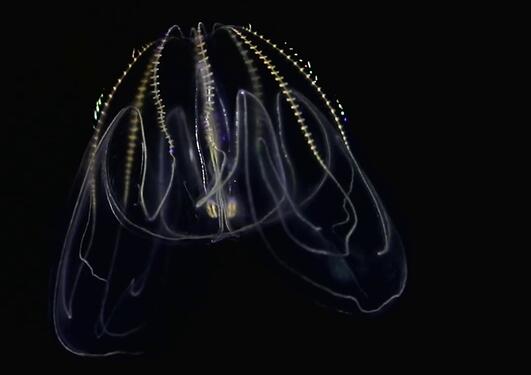Paris Aquarium scientists visit Bergen to exchange new jelly species
This month, collaborators from Paris Aquarium visited the Michael Sars Centre. They brought with them an unusual species of ctenophore, and went on a mission to collect Norwegian specimens for Europe’s largest jellyfish exhibit.

Main content
From May 5 to 11, the Paris Aquarium general curator Eduardo Da Forno and his colleague Étienne Bourgouin, jellyfish curator, visited the Michael Sars Centre as part of the collaboration between the two institutions. On the agenda was an ambitious hunt for jellyfish along the Bergen coast and the addition of a new comb jelly species to the Centre’s Ctenophore Facility.
“We currently exhibit scyphozoans, so big, colored jellyfish… The jellyfish that people have in mind when they talk about those animals. But we want to explain what the diversity inside the jellyfish world is”, explained Bourgouin. To achieve this goal, the aquarium’s Medusarium© will soon be expanded with a section showcasing hydrozoans, a group consisting mostly of smaller jellyfish. The Paris Aquarium team is currently traveling the world to collect specimens for the new display, from Japan to South Africa and the French West Indies. However, their ‘species Christmas list’ could not be fulfilled without a detour to the Norwegian fjords.
With the help of Alexandre Jan, ctenophore aquarist in the Burkhardt group at the Michael Sars Centre, Da Forno and Bourgouin spent a week diving and collecting hydrozoans. The animals were acclimated in the Ctenophore Facility before starting their journey to the French capital. “All the animals we collect are special to us, they are all magnificent”, said Da Forno. “But personally, I absolutely wanted to see Stauromedusae again. They are jellyfish that do not swim but live attached to algae. We managed to find three specimens!”

The benthic ctenophore Coeloplana meteoris adjusted well to the Ctenophore Facility.
The team did not come to the Centre empty-handed. In their luggage was Coeloplana meteoris, a peculiar ctenophore species. Unlike other ctenophores, which are free-swimming, Coeloplana has a benthic lifestyle - it lives attached to the seafloor, hunting prey above using two long tentacles. "Benthic ctenophores are a distinct group within the comb jellies alive today, they branched off earlier during evolution”, explained group leader Pawel Burkhardt. “If you want to understand ancestral characters within ctenophores, they are a key species. We are very excited to have them at the Centre!”
The visit was marked by genuine enthusiasm as Jan, Da Forno and Bourgouin exchanged tips over their shared passion for caring for the ocean’s inhabitants. “How can we get the general public interested in preserving these species if they don't know what's out there? It's important to be able to present them to the public and attract their attention”, Da Forno concluded. “Then they might be more interested in all the things that accompany us on this planet.”


